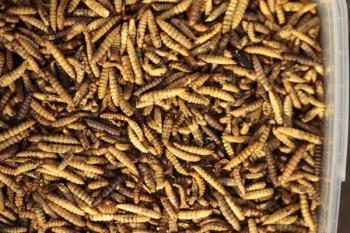
Nutrition in practice (Proceedings)
The goal of clinical nutrition is to sustain the nutritional health of the pets we care for without adversely affecting the quality of the bond between our clients and their pets. To do this we consider the signalment of the animal, the most suitable diet to recommend given the pets physiological state and (or) disease, and the most appropriate feeding strategy for both the pet and her owner.
The goal of clinical nutrition is to sustain the nutritional health of the pets we care for without adversely affecting the quality of the bond between our clients and their pets. To do this we consider the signalment of the animal, the most suitable diet to recommend given the pets physiological state and (or) disease, and the most appropriate feeding strategy for both the pet and her owner. An associated issue, at least in our practice, is that many urban clients do not have extensive experience as pet owners, and appreciate advice that may seem elementary to veterinarians.
Animal
As we approach the animal, we note its age, physiological state, and the amount of activity it engages in. We're lucky when presented with a puppy or kitten so we can get owners off to the right start. This is the time to recommend a diet you trust, and to discuss any information, or misinformation, the client may have received about feeding their new pet. We become concerned when a client reveals that a bizarre diet is fed, a variety of supplements provided, or when a well-meaning breeder has recommended an overly strict or unusual feeding regimen. Listening to the client's concerns, and explaining that pet food quality has improved so much that supplementation no longer is necessary, and may be hazardous, usually convinces them of the wisdom of feeding a prepared pet food. If not, I recommend that the patient be returned more frequently to ensure that all continues to go well.
The initial visit also is the time to explain that urban pets, like urban people, are at risk of obesity due to ready availability of highly palatable foods, the lack of readily available opportunities for calorie-burning activities, and the stress of living in confined spaces. To prevent future problems with obesity and begging for food, the client may need help learning to feed to a moderate body condition and to establish a tradition of non food-related interactions with their pet. Owners can be taught to feed whatever amount of food is necessary to maintain a moderate (3/5 or 5/9) body condition. If they have limited experience with animals, they should be shown the elements of moderate body condition by having them palpate the ribs and waist under your supervision, so you can advise them if the animal needs more, less or the same amount of food. Another advantage of teaching owners to feed according to body condition is that it is the same method they use (or should use) for themselves. Few people know how many cups or calories of food they need to eat to maintain moderate body condition. We usually decrease our intake when we notice that our clothes are becoming too snug, and we can teach our clients to do essentially the same thing with their pets.
We also can help clients maintain their pets body condition by recommending non food-related interactions. Teaching tricks, playing with the pet, and walking regularly instead of feeding the pet when it wants attention all help maintain a bond that is not sustained with food. Owners sometimes confuse begging for attention with begging for food. They can differentiate the two by throwing a favorite toy for the pet to fetch when it looks longingly at them. If it fetches the toy, it was more interested in attention than food.
Diet
One of the most common nutrition-related client questions is, "what should I feed my pet?" Veterinarians can learn to answer this question confidently by obtaining brief diet histories from all their clients, and creating a list of diets that seem to perform well for these animals. Criteria to consider include:
For animals at maintenance
1. Do animals have an appetite for the food? Will they eat enough to maintain themselves?
2. Is the quality and volume of the feces acceptable to you and the owner? Loose and/or voluminous feces suggest poor digestibility and/or low energy density.
3. Is the coat quality acceptable to you and the owner? Poor coat quality can be caused by a number of nutritional inadequacies, and suggests low diet quality.
4. Is the diet economical to feed? Cost per day rather than cost per container should be determined, because of the differences in diet quality and energy density.
5. Is the animal's weight and body condition acceptable?
a. If overweight, is too much food offered? Too little exercise provided?
b. If underweight, is enough food being offered?
For pregnant and lactating animals - In addition to the above criteria:
1. Is the dam's weight gain during gestation acceptable?
2. Is the dam's weight and body condition maintained during lactation?
3. Is the physical condition of the offspring normal?
4. Is the weight gain of the offspring appropriate for the breed, number of pups and parity of the dam?
For veterinary foods - In addition to 1,3,4, and 5 above:
1. Are the nutrient modifications appropriate for the disease the diet is intended for?
2. Is there supporting evidence, based on testing in a relevant patient population of the suitability of the diet? N.B. the FDA requires drugs, but not foods to demonstrate safety and efficacy.
Clinicians have a daily opportunity to evaluate the quality of diets. One can most confidently recommend those with which one has had positive experiences, and against diets when a pattern of inadequacy is discerned. Moreover, absence of a product from one's list does not mean that it is unacceptable, only that insufficient experience with it has been obtained. This method of choosing diets to use and recommend is analogous to the decision-making process for many pharmaceutical preparations; it is based on personal experience and judgment rather than marketing claims that may be irrelevant to one's own circumstances. When clients ask about a food one is unfamiliar with, the following general parameters may be considered when one is uncomfortable with saying, "I don't know.":
1. Manufacturer's reputation - have you ever heard of them before? Are you familiar with other products from this manufacturer?
2. Does the nutrition guarantee ("Complete and balanced for ___ stages of a ____'s life…) contain the words "feeding studies"? If so, it means that the manufacturer was sufficiently concerned with the quality of their product to feed it to animals before offering it for sale.
The majority of urban pets are inactive, neutered adults. The nutrient needs of these animals are not great, but may need to be provided in the small volume of food needed to maintain moderate body condition. This volume may be much less than label suggestions. Clients often misunderstand that manufacturer's feeding directions are only initial guidelines, often established based on the intakes of quite active animals. These owners should be informed that individual animals may need to eat twice, or half, as much as label recommendations to maintain moderate body condition, depending on its temperament and activity. I've had my students measure the food intake their pets need to maintain moderate body condition for many years. Most find that their pets consume enough to meet resting energy needs (20 kcal/lb. body weight/day), probably due to inactivity. Clinicians may ask if the small volume of food needed to maintain their pet's condition concerns an owner, and be ready to recommend a lower energy density food that one has experience with. There are many high-quality, reduced calorie foods currently available for treatment of obesity. I think we might recommend these foods sooner, to prevent development of obesity, rather than later to treat it.
Lowering the fat content, and diluting with water, air or fiber can reduce calories in food; some foods use variable combination of these approaches. Regardless of the method used, however, the amount fed still must be controlled. In humans, the explosion in availability of reduced fat foods during the past ten years has not been able to stop a nearly 50% increase in the prevalence of obesity among Americans. Our pets also can become fat fed low-fat foods if the amount they eat is not monitored. If increased fiber foods are recommended, warning the client about the increased feces volume that results can avoid surprise and dismay at the presence of this effect.
When small amounts of food are fed, one must be attentive to ensure that the needed amount of each nutrient is consumed. This is particularly a concern with protein. Dogs need at least a gram per pound body weight per day to maintain protein reserves, cats at least one and a half. The smaller the amount of food consumed, the higher the % protein in the diet must be to ensure that needs are met. This can be estimated from the pet food label, which always states the minimum protein percentage, and the weight per unit of food. A dry food that reports 24% protein and weighs 100 gm. per 8oz measuring cup contains 24 grams of protein per cup food. If this food contains 360 calories per cup and dogs eat 30 calories per pound, as is commonly recommended, one cup would be appropriate for a 12 pound dog. The dog would get 24 gm/12 pound or 2 grams per pound per day. If the dog consumed only 15 calories per pound to maintain a moderate body condition, however, it would only receive 1 gram of protein per pound per day. This might not be enough to sustain its protein reserves, and could put the pet at greater risk for complications if it suffers an infection, requires surgery, or for any other reason needs to call upon these reserves.
Feeding
Client may benefit from help in learning to feed their pet(s) to a moderate body condition, and to establish a tradition of non food-related interactions to prevent future problems with obesity and begging for food. Owners should be taught to feed whatever amount of food is necessary to maintain a moderate (3/5 or 5/9) body condition (an example is available here:
We also can help clients maintain their pet's body condition by recommending non food-related interactions. Providing play treats, such as teaching tricks, playing with the pet, and walking regularly instead of food treats the pet when it wants attention all help maintain a bond that is not held together with food. Owners sometimes confuse begging for attention with begging for food. They can differentiate the two by throwing a favorite toy for the pet to fetch when it looks longingly at them. If it fetches the toy, it was more interested in attention than food.
Once owners understand how to feed their pet to maintain a moderate body condition, the frequency and timing of feeding can be adjusted to their convenience to maintain this condition, and to facilitate toilet habits in growing animals. The number of feedings necessary to maintain the desired condition ranges from continuous availability of food to one small meal per day. I generally recommend that owners feed dogs when they can be walked shortly afterward, usually after work. A small meal in the morning before they leave for work is all right, but the majority of the food should be fed when the owner is at home to reduce begging if only small amounts can be fed.
Owners who spend large amounts of time at home with the pet are especially likely to want to provide their pet with treats. We can help them do this without sacrificing the pet's body condition by teaching them the difference between replacing calories and supplementing them. If they want to give food treats, they need to understand that these should replace some the pet's regular food, not be added to it. Some clients are willing to set part of the daily ration of dry food apart to provide as treats, or to reduce the daily ration so they can provide treats. As long as the treats don't account for more than about 20% of the daily calories, this practice is not dangerous to the pet, and may bring great enjoyment to some owners.
As with indoor housed cats, clients also can be encouraged to implement more environmental enrichment for Dogs; the following information has been adapted from a handout by Lore I. Haug, DVM, MS, DACVB:
Wild animals spend the majority of their time foraging for food and avoiding predators. In contrast, the average pet dog spends less than 5 minutes per day eating. They do not have to forage for food or avoid predators. Or do much of anything else, because they are essentially captive animals, often kept in monotonous environments. Most dog breeds were developed for a specific purpose (guarding, herding, hunting, etc.), but few dogs currently participate in any of these activities. This situation deprives dogs of the opportunity to express their species-typical behaviors, or to receive environmental stimulation. Inadequate stimulation can result in problem behaviors, such as hyperactivity, destructive chewing, excessive attention-seeking, stereotypic or compulsive activities, and aggression.
Enriching the environment of "captive" pets can help by encouraging a more normal range of behavior, and reduce boredom by constructively occupying more of the pet's time.
Enrichment activities for dogs
Food-related
Indoor
1. Feed using a foraging device such as a Buster Cube, Roll-A-Treat ball, tug-a-jug or Canine Genius.
2. Place dog food or treats inside a cardboard box, old towel/rag, or plastic jugs and allow the dog to tear the item apart to get to the food inside.
3. Scatter food across the floor house so the dog searches for each piece.
4. Stuff Kong toys full of various food items (or the dog's meal) and freeze them overnight before giving them to the dog.
5. Divide portions of the dog's meal into small Tupperware containers and hide them around the house for the dog to find.
6. Place novel scents in the environment using small amounts of spices, herbs, extracts, or synthetic animal scents (rabbit, quail, squirrel, etc. are available from sporting goods stores and websites).
7. Add sugar-free Kool-Aid, Gatorade powder, or bullion (or other broths) to water and freeze into a popsicle in a variety of sizes of Tupperware. Pieces of food items; cereal, fruit, vegetable, dog food, cheese, meat, etc. can be added to these to increase variety.
Outdoor (in addition to the above)
1. Scatter the dog's food, fruits or vegetables (e.g., melons, apples, lettuce, squash, carrots, celery, etc.) in the yard, bury them in a sand box, or float them in a wading pool. (Do not give grapes or raisins, as some of these have been found to be toxic to some dogs.)
Dr. Haug recommends that dogs receive their entire daily ration of food during training or from enrichment devices. The devices may be rotated so the pet does not see the same item every day. Not all dogs will be able to participate in all the suggested activities. Dogs also vary in their propensity for destroying and/or eating toys, so toys should be offered initially to dogs while under direct supervision if one is concerned about the dog's likelihood to destroy the device, and injure itself in the process.
Play related
Indoor
1. Provide both toys (e.g., squeakies, rope toys, stuffed animals, rubber toys, balls, etc.) and chewing items (Nylabone, Galileo bones, rawhide bones, etc.) (they serve different enrichment purposes).
2. Teach the pet tricks, throw toys up flights of stairs for the dog to fetch, teach "doggie calisthenics"; "sit-down-sit".
Outdoor
1. Provide a sand box by sectioning off an area in the yard, or by buying a child's wading pool and filling it with sand and dirt.
2. Buy and fill a child's wading pool with water; if the dog enjoys both water and digging, the substrate in the pool can be alternated.
3. Hang rope or inner-tubes from a branch or other structure in the yard for the dog to tug on.
4. Offer liquid bottles or milk jugs made of either cardboard or plastic. The dog's interest may be stimulated by putting food items inside. (Always remove the plastic rings and the plastic caps before allowing dogs to play with these items.) Many dogs will also play with 5-gallon water jugs.
5. Some dogs will play with old tires that are lying on the ground or hanging from ropes.
6. Implement training sessions and other dog sport activities (flyball, agility, tracking, Frisbee, etc.).
Newsletter
From exam room tips to practice management insights, get trusted veterinary news delivered straight to your inbox—subscribe to dvm360.






